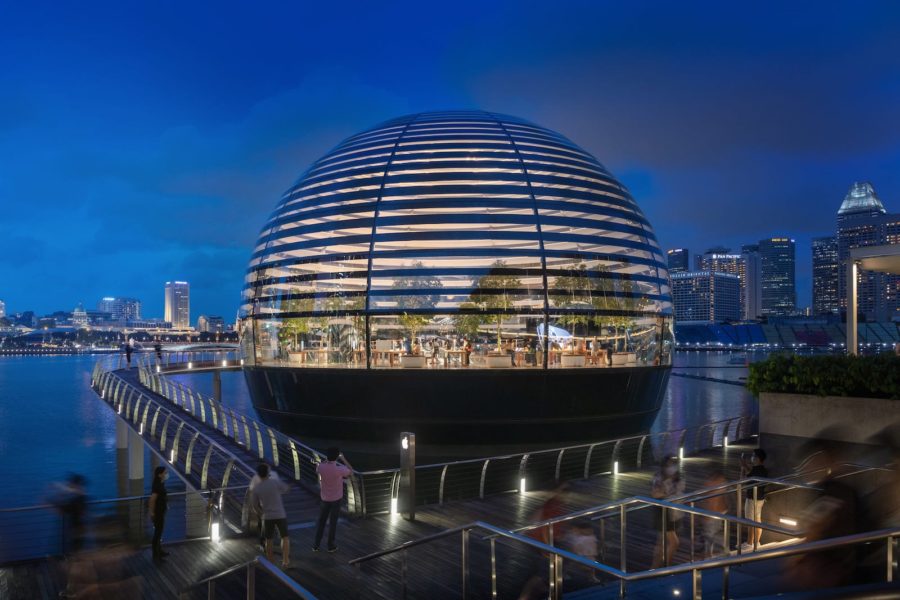神田川から小石川台地へと登る長い坂道の中腹に計画地はある。北側隣地は敷地より3m高く、南側隣地は敷地より3m低い雛壇状の場所である。建主からは眺望の良さを活かした家にしたいとの要望があった。周辺には高低差がつくる特徴的な街並みが散見され、擁壁に沿った坂道や階段を登り切ると、新たな視点や眺望が開けるという空間体験が印象的であった。
ここでの課題は、がけ条例によって必要とされるRC造の高さ3mの擁壁や、コンパクトな敷地にかかる3方向からの斜線制限という厳しい条件の中で必要面積をどう成立させるか、そしてどのようにこの場所ならではの建築をつくることが出来るかということであった。
がけ条例に対しては、基礎の一部を3mの高基礎として擁壁の機能を兼ねる形とし、外断熱とすることで室内に擁壁のコンクリートを現した。これは擁壁本来の目的である住まいを守るという役割を室内側に示したものである。ただ、通常の打ち放し仕上げでは大味になりすぎるため、型枠に布を貼って打設することで、繊細で湿度感のある土壁のような素材感とした。
1階に水回りと寝室、2階に居間と食堂、3階に子供室を計画し、階段は斜線制限を避けるように配置し、螺旋状に上階へと上る空間構成とした。2階へはRCの擁壁に沿うように階段を上り、その後方向を変え3階へ上がり切ると、眼下に街の風景が広がる。敷地の条件に向き合った結果、この街特有の空間体験を内部のシークエンスとして取り入れる形となった。
コンパクトな各階の面積に対して、この街の路地に見られる小規模な木造住宅の表情がつくる、小さな空間に高い密度感が存在する親密な空気感を室内でも実現したいと考えた。同時に、端正なディテールやプロポーションは建主家族の雰囲気に合うだろうとも感じた。羽目板やフローリングなどの素材の単位を細分化し、ディテールを構成する要素も徒に線を消さず、むしろ必要な線を適切な形で存在させることで、この街の空気感と違和感なく繋がりをもった密実な空間を目指した。
敷地が面する坂道は江戸時代から存在する歴史ある道で、この坂道を含む景観にふさわしい佇まいを心がけた。外観はいくつかの小さなボリュームが組み合わさる形としたうえで、ダイニングから坂道を捉えるように角度を振った出窓は、この家のささやかなキャラクターとして存在している。そして、この出窓は室内から眼下の街並みを眺めるためのものであると同時に、坂道のある景観の中においてここが眺めの良い場所であり、人の生活の営みがあることを示している。
建主の暮らしが始まり、夕暮れ時に部屋に明かりが灯った姿を見た時、この住宅が坂道の景観の新たな一員となっていくことを実感した。(森田悠紀)
A house incorporates the spatial experience of the slope as an interior sequence
The site is located in the middle of a long slope that rises from the Kanda River to the Koishikawa Plateau. The northern neighbor is 3 meters higher than the site, and the southern neighbor is 3 meters lower than the site. The client requested that the house take advantage of the view. The surrounding area has a characteristic townscape created by the undulating topography, and the spatial experience is impressive in that it opens up new perspectives and views as one climbs the slope and stairs along the retaining wall. The challenges of this project were how to incorporate a 3 meter high RC retaining wall, as required by the cliff ordinance, and how to secure the necessary floor area on a small site with diagonal restrictions from three directions. Most importantly, what kind of architecture would be appropriate for this site?
To comply with the cliff ordinance, part of the foundation is a 3-meter-high retaining wall, and the concrete material of the retaining wall is shown inside the house by insulating it from the outside. This is to show the primary purpose of the retaining wall, which is to protect the house, inside the house. However, the usual exposed concrete finish would have been too rough for the interior, so the concrete was poured using fabric-covered forms. This gave the concrete a delicate material feel.
The building consists of a bathroom and bedroom on the first floor, a living room and dining room on the second floor, and a children’s room on the third floor. The stairways on each floor are arranged to avoid oblique constraints, and the flow line spirals up from the first floor to the third floor. The stairs from the first floor to the second floor climb along the RC retaining wall, and then change direction and climb from the second floor to the third floor to enjoy the panoramic view of the city. As a result of facing the site conditions, the interior sequence was designed to incorporate the characteristic spatial experience of the city.
For the small area of each floor, I thought it would be good to achieve the intimate atmosphere of high density in a small space, which is characteristic of the alleys in this city. I also felt that the clean details and proportions of the house would suit the atmosphere of the client’s family. I divided the materials such as paneling and flooring into smaller units and did not erase the lines of detail, but rather allowed the necessary lines to exist in their proper forms. The goal was to create a dense space that is connected to the atmosphere of the city without feeling out of place.
The slope adjacent to the site is a historical road that has existed since the Edo period, and I tried to give the building an appearance appropriate to the landscape with this slope. The exterior of the house is a combination of several small volumes, and the bay window angled to capture the slope from the dining room is a small character of the house. The bay window is used to view the city below from inside the house, and at the same time it indicates that this is a place with a good view in the landscape with a slope, and that there is human life activity.
When I saw the light in the room at dusk, I realized that this house would become a new part of the hillside landscape. (Yuki Morita)
【春日の家】
所在地:東京都文京区
用途:戸建住宅
クライアント:個人
竣工:2022年
設計:森田悠紀建築設計事務所
担当:森田悠紀
構造設計:蒲池 健(KMC)
施工:水雅
撮影:西川公朗
工事種別:新築
構造:木造
規模:地上3階
敷地面積:64.90m²
建築面積:39.80m²
延床面積:97.16m²
設計期間:2021.01-2021.12
施工期間:2022.01-2022.07
【House in Kasuga】
Location: Bunkyo-ku, Tokyo, Japan
Principal use: Residence
Client: Individual
Completion: 2022
Architects: Yuki Morita Architects
Design team: Yuki Morita
Structure engineer: Ken Kamachi / KMC
Contractor: Suiga
Photographs: Masao Nishikawa
Construction type: New building
Main structure: Wood
Building scale: 3 stories
Site area: 64.90m²
Building area: 39.80m²
Total floor area: 97.16m²
Design term: 2021.01-2021.12
Construction term: 2022.01-2022.07








